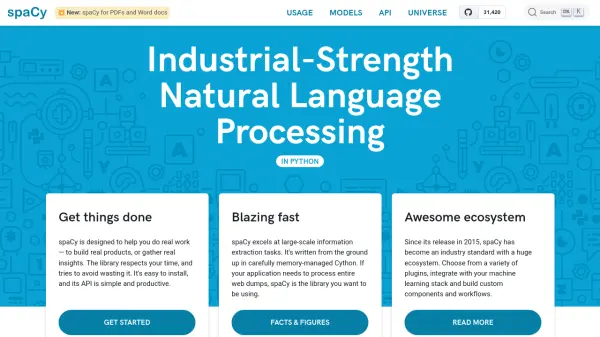What is spaCy?
spaCy is a prominent open-source software library designed for advanced Natural Language Processing (NLP), written in Python and Cython. It's built with a focus on practical application, enabling users to develop real products and derive meaningful insights from text data. Engineered for efficiency and ease of use, spaCy provides a simple API and is straightforward to install, respecting the developer's time. It excels particularly in large-scale information extraction tasks due to its high speed and careful memory management, making it suitable for processing extensive datasets like web dumps.
Since its inception in 2015, spaCy has become an industry standard, supported by a vast ecosystem including various plugins and integrations with common machine learning stacks. Users can build custom components and workflows tailored to specific needs. The library offers robust support for over 75 languages, featuring numerous pre-trained pipelines. Key functionalities encompass linguistically-motivated tokenization, named entity recognition (NER), part-of-speech (POS) tagging, dependency parsing, text classification, and more. Recent developments include the `spacy-llm` package, which integrates Large Language Models (LLMs) into structured NLP pipelines without requiring task-specific training data.
Features
- Language Support: Trained pipelines for 25 languages and general support for 75+ languages.
- Transformer Integration: Multi-task learning with pretrained transformers like BERT.
- Performance: State-of-the-art speed and accuracy, optimized for large-scale tasks.
- Production-Ready Training: Comprehensive system for configuring, training, and deploying custom models.
- Core NLP Components: Includes tokenization, NER, PoS tagging, parsing, text classification, lemmatization, and more.
- Extensibility: Easily add custom components, attributes, and models (PyTorch, TensorFlow).
- LLM Integration: Modular system (spacy-llm) for integrating Large Language Models into structured NLP pipelines.
- Visualization Tools: Built-in visualizers for syntax and Named Entity Recognition (NER).
Use Cases
- Building NLP-powered applications and products.
- Large-scale information extraction from text data (e.g., web dumps).
- Training custom NLP models for specific tasks (NER, text classification, etc.).
- Performing linguistic analysis (part-of-speech tagging, dependency parsing).
- Integrating Large Language Models (LLMs) into structured NLP workflows.
- Preprocessing text data for machine learning pipelines.
- Analyzing text for insights in research or business intelligence.
FAQs
-
How does spaCy integrate with Large Language Models (LLMs)?
spaCy integrates LLMs via the `spacy-llm` package, providing a modular system for prototyping and prompting. It helps turn unstructured LLM responses into robust, structured outputs suitable for various NLP tasks without needing specific training data. -
What kind of NLP tasks can spaCy perform?
spaCy supports a wide range of NLP tasks including named entity recognition, part-of-speech tagging, dependency parsing, sentence segmentation, text classification, lemmatization, morphological analysis, and entity linking. -
Is spaCy suitable for production environments?
Yes, spaCy is designed for industrial-strength NLP and building real products. It offers features like production-ready training systems, easy model packaging, deployment, and workflow management. -
Can I train my own models with spaCy?
Yes, spaCy provides a comprehensive system for configuring and training custom pipelines, allowing you to create models tailored to your specific needs.
Related Queries
Helpful for people in the following professions
spaCy Uptime Monitor
Average Uptime
100%
Average Response Time
126.73 ms
Featured Tools
Join Our Newsletter
Stay updated with the latest AI tools, news, and offers by subscribing to our weekly newsletter.








